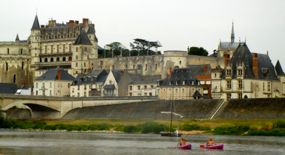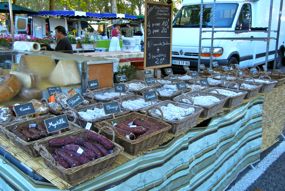 |
What to See & Do in Amboise | |
| Amboise has not one but two châteaux, as well as churches, museums, and a great market! | ||
|
|
|
The charming town of Amboise, with its Château sitting high above the River Loire, is a great place to base your Loire region visit and spend a few days. The main draw is the Château d'Amboise, home of Kings Charles VIII, Louis XII, and François I (and other French royalty), and right in the center of town. Just up the road is the Château du Clos Lucé, childhood home of François I and his sister Marguerite de Navarre, and the final home of Leonard da Vinci, who came to Amboise in 1516 at the invitation of the King. Amboise also boasts a lovely pedestrian street, the Rue Nationale, which passes under the 15th century Clock Tower. The street is lined with small shops and patisseries, with many temptations. On Fridays and Sundays, stroll down to the parking lot by the river, just across from the Tourist Office, and enjoy the wonderful Amboise Market. You'll find everything from cheese to sausages to flowers to clothes to kitchen tools—even beds! Prepared food stalls provide delicious lunches, dinners, or picnic supplies. You'll also see traditional boats on the Loire in Amboise, and boat trips can be arranged. Check with the Tourist Office for specific information. The bridge that spans the Loire at Amboise provides access to a small island, the Ile d'Or. You can stroll by the river's edge, visit the 11th century Saint-Jean Chapel, enjoy the fauna and flora of the region, or sip a drink at Le Shaker, a riverside restaurant. The bridge also provides fabulous views of the Château, particularly at sunset. The Musée de l'Hotel de Ville, just off the Rue François I as you enter the center of town, is housed in a 16th century mansion that served as the Town Hall until 1970. Its collection includes statues, paintings, furniture, and a room dedicated to Leonard da Vinci. Just across from the Musée is the Église Saint-Florentin, built under Louis XI in 1469. Named a historic monument in 1963, but closed to the public in 1993, it re-opened in 2010 after some restoration work. Its stained glass is modern (1956, Max Ingrand), following damage in World War II. In 1767 the parish was divided between Saint-Florentin and Saint-Denis.The Église Saint-Denis is at the far end of the Rue Nationale, on a hill overlooking the downtown. In addition to all the specific sights, Amboise is also a great town for wandering. You'll find old half-timbered houses, window boxes exploding with flowers, and a variety of restaurants, hotels, and shops. Be sure to look at the Château from various vantage points too.
|
|
Above, Château d'Amboise, seen from the Ile d'Or. |


